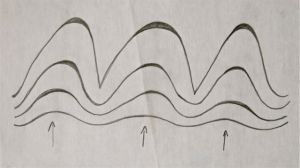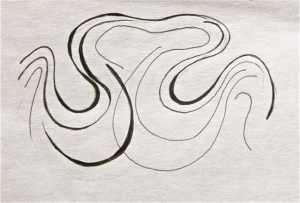Educationalist Guy Claxton has suggested that the walls of halls in schools should be covered the the progressive stages of creative works, so that children could see the “soft” stages of a creativity, the incompleteness and open-endedness that characterise the unfolding of a creative process, rather than only seeing the end products, the works of art themselves. In this way, children would learn that creating something doesn’t come from one attempt. But I could add that to be creative is to go through a process of seeing many alternatives, following some or many of them but not knowing or even projecting the outcome from the start. This is what being creative is about – imagining alternatives.
Documenting each progressive stage of an artistic process is not a new idea on Claxton’s part, though displaying them on school halls may be. Many artists of all genres keep records – sketches, field notes, drafts – for their own benefit as well as clients, but often they are still end-product oriented. Where I was trained, the process was considered so important that we were almost trained out of bringing a work to completion! Or so I felt at the time.
However, there is another approach to displaying or capturing the process of a creative work, and that is to create a series out of the process: each stage is a separate work, to be viewed by an audience as a progression. Sometimes the early stages would be a few line in a sketch or formless colour moods. Sometimes they would be quite developed works in themselves that could stand alone, as “finished”. But each work in the series could be seen to have a relationship to the previous or next work. The audience would see each work standing alone but only as one part of a larger work. Naturally, the works of a series must be placed in some sequential order. Only in the eyes of the artist might the finished whole have another stage. It’s about imagining alternatives to each step of the sequence.
In a sense, no-one ever really starts anything completely new. There can be years between stages, but you can always find a creative act’s origin in an earlier act.After all, as Leonardo da Vinci said “Art is never finished, only abandoned.”
Going through my old drawing exercises I see the same gestures and motifs appear again and again, yet always transformed by time: in the form and between the forms. The forms may reflect movement through time, such as leafing to seeding; but there may be years between the creation of each stage, such as the six Sunlit Tree motifs here.
Or each new stage may start off where the last left off, as in the three drawings posted below. Though each series or cycle is responding to different forces and dynamics, both internal and external, there is always a sense of movement and transformation, though each stage may not obviously look related to the previous. Often you literally copy the previous stage then moving it around, in the case of the pastels, because chalk pastel is a very flexible medium.
In these three sketches, the same process is at work.
 The 1st Sketch began with the concept of the static, straight line, which never occurs in Nature. When you bring it into Nature, which drawing by hand will do, it immediately gains a little dynamic. If this dynamic is increased from one direction, then it responds to that unseen but intrinsic dynamic: when repeated, it shows its response to that force by becoming, line by line, increasingly acute in its curve.
The 1st Sketch began with the concept of the static, straight line, which never occurs in Nature. When you bring it into Nature, which drawing by hand will do, it immediately gains a little dynamic. If this dynamic is increased from one direction, then it responds to that unseen but intrinsic dynamic: when repeated, it shows its response to that force by becoming, line by line, increasingly acute in its curve.
 By the 2nd sketch, the final line from the 1st is now reacting to much stronger forces coming from a different place, diagonally from within & without. The line then responds differently, increasing its dynamic and moving further from its origin as an almost static line. Yet the line is also responding to the human-made movement, to a certain gesture of inner/outer (it’s harder to explain this with words than to demonstrate).
By the 2nd sketch, the final line from the 1st is now reacting to much stronger forces coming from a different place, diagonally from within & without. The line then responds differently, increasing its dynamic and moving further from its origin as an almost static line. Yet the line is also responding to the human-made movement, to a certain gesture of inner/outer (it’s harder to explain this with words than to demonstrate).
 In sketch 3, Sketch 1 is repeated in gesture, but this time, in response to human movement as a primary force is removed, when the previously unseen force is now revealed by the fine lines that turn the line into surface. The whole effect is quieter as it moves from surface into space.
In sketch 3, Sketch 1 is repeated in gesture, but this time, in response to human movement as a primary force is removed, when the previously unseen force is now revealed by the fine lines that turn the line into surface. The whole effect is quieter as it moves from surface into space.
This form of drawing can be described as metamorphic.
Metamorphic Drawing
Metamorphic drawing is rhythmical but never becomes repetitive or mechanical. It never uses the same line twice but each line is a transition from the previous line (see Sketches 1, 2 and 3). So the drawing gesture never falls into repetition, but is always subject to the “law” of the previous gesture. This form of drawing can be surprisingly difficult to to get used to – we easily want to fall into repetition – as it requires use to be continually inwardly awake and completely engaged with the drawing, in the present moment, yet alert to its future possibilities.
Practicing metamorphic drawing can bring flexibility and mobility into our cognitive processing patterns, bringing the dynamic ebb and flow that generates the conditions that allow for deep and creative thinking, where new ideas can arise.

[…] process. But this process can be further enhanced by using a particular form of drawing, called metamorphic drawing. Based on the natural water and air forms described by Schwenk, metamorphic drawing can bring […]
[…] moves in natural cycles that are metamorphic, not repetitive, as I wrote about in a much earlier post on drawing. Through each immersion in the medium, into the experience, there is transformation, but […]